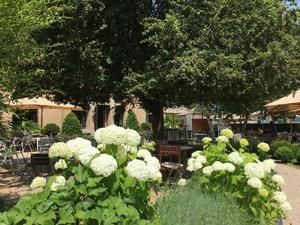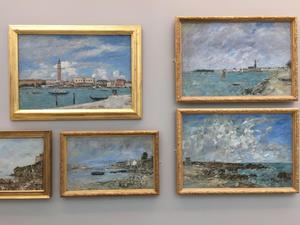As international ports go, Le Havre in Seine-Maritime doesn’t immediately sound like it’s packed with tourism potential. Situated on the north side of the Seine estuary, the docks and city centre were virtually destroyed in WW2, the city rebuilt in the 1950s to house 80,000 homeless citizens.
 But it’s precisely that reconstruction that makes Le Havre a fascinating place to spend the day. And maybe the night as well. Today’s city is much more than a cruise ship stopover and container port. As well as being gateway to the picturesque Seine Valley and the beautiful Alabaster Coast, it offers a unique – and often very moving – architectural heritage, the only post-War city in the world to be awarded UNESCO World Heritage status.
But it’s precisely that reconstruction that makes Le Havre a fascinating place to spend the day. And maybe the night as well. Today’s city is much more than a cruise ship stopover and container port. As well as being gateway to the picturesque Seine Valley and the beautiful Alabaster Coast, it offers a unique – and often very moving – architectural heritage, the only post-War city in the world to be awarded UNESCO World Heritage status.
So instead of rushing straight into – or out of – the cruise terminal, take time to look around. And if you fancy a short break without the car, book a cabin for the overnight crossing with Brittany Ferries from Portsmouth, catch the bus to the city centre, and travel back overnight next day.
All through the summer until 23 September various outdoor artworks, exhibitions and performances are on offer as part of Un Été au Havre – Summer in Le Havre – an initiative which will run again from late June 2019. Pick up the booklet from the Tourist Office which offers three colour-coded trails linking temporary arts installations and permanent architectural highlights.
 The centre of Le Havre is easy to navigate on foot, with broad, tree-lined avenues and plenty of open spaces. And with the central Town Hall barely 500 metres from the beach, you are never far from the sea. If time is limited, there are two must-see attractions, the Museum of Modern Art André Malraux (MuMa) and the towering Church of Saint Joseph – of which more later – but to really understand what this city’s all about, I’d recommend a guided tour.
The centre of Le Havre is easy to navigate on foot, with broad, tree-lined avenues and plenty of open spaces. And with the central Town Hall barely 500 metres from the beach, you are never far from the sea. If time is limited, there are two must-see attractions, the Museum of Modern Art André Malraux (MuMa) and the towering Church of Saint Joseph – of which more later – but to really understand what this city’s all about, I’d recommend a guided tour.
At the time of writing there are no regular group tours in English, though the English-speaking Visitor Information Centre can advise on whether a particular guide speaks English. Better still, book a private tour. My English-speaking guide Lise was both knowledgeable and passionate about her city.
 We meet at Saint Joseph Church, completed in 1957 and the towering figurehead of the city’s regeneration. I’d never had myself down as a concrete fan but the geometric design of the interior was designed by celebrated Auguste Perret who, at the age of 70, took charge of rebuilding the city. His use of coloured concrete combined with nearly 13,000 panes of stained glass by Marguerite Huré is breathtaking.
We meet at Saint Joseph Church, completed in 1957 and the towering figurehead of the city’s regeneration. I’d never had myself down as a concrete fan but the geometric design of the interior was designed by celebrated Auguste Perret who, at the age of 70, took charge of rebuilding the city. His use of coloured concrete combined with nearly 13,000 panes of stained glass by Marguerite Huré is breathtaking.
Sadly Perret died in 1954 at the age of 80, so didn’t live to see St Joseph finished. But he left the task of rebuilding the devastated city to his team of architects who worked with local specialists to complete Perret’s ingenious construction plan. His legacy is a homogenous design that marked a new style of urban living.
Lise shares all kinds of insider information with us, but she doesn’t only have knowledge. Lise has keys! The panoramic terrace on the 17th floor of Perret’s Town Hall – inaugurated in 1958 – is only accessible with an accredited guide. So too is the Perret Show Flat, unaltered across the decades, and furnished with all the latest appliances and furnishings of the period. If you fancy a real nostalgia immersion, book an overnight stay in the ‘50s-style atmosphere of the Oscar Hotel in the city centre.
 Surprisingly, Le Havre miraculously retained a few pre-War properties. The church of Notre Dame was badly bombed but painstakingly restored, becoming the city cathedral in 1974. And the Natural History Museum is housed in the former law courts. It’s all in stark contrast to Le Volcan nearby, a volcano-shaped arts centre designed by Oscar Niemeyer.
Surprisingly, Le Havre miraculously retained a few pre-War properties. The church of Notre Dame was badly bombed but painstakingly restored, becoming the city cathedral in 1974. And the Natural History Museum is housed in the former law courts. It’s all in stark contrast to Le Volcan nearby, a volcano-shaped arts centre designed by Oscar Niemeyer.
When hunger beckons, I can recommend Les Enfants Sages in rue Gustave Lenier, close to Le Volcan, which offers al fresco dining in a shady garden or inside tables in a former headmaster’s house. Their 2-course Canteen Lunch was good value and delicious at €16.
 Le Havre’s other must-see attraction, MuMa, stands on the sea front close to the estuary, flooded with light and the perfect environment to display France’s second largest Impressionist Collection outside Paris. It was in 1872 that Claude Monet painted a picture of the sun emerging from behind the city’s industrial chimneys entitled ‘Impression, Sunrise’. An art critic, somewhat unimpressed, dubbed it a work of Impressionism and the name just stuck.
Le Havre’s other must-see attraction, MuMa, stands on the sea front close to the estuary, flooded with light and the perfect environment to display France’s second largest Impressionist Collection outside Paris. It was in 1872 that Claude Monet painted a picture of the sun emerging from behind the city’s industrial chimneys entitled ‘Impression, Sunrise’. An art critic, somewhat unimpressed, dubbed it a work of Impressionism and the name just stuck.
Today MuMa is also home to the largest collection anywhere by ‘Master of Skies’ Eugene Boudin, and there are paintings too by Monet, Sisley, Pissarro and Renoir, plus artworks from other periods and temporary exhibitions. MuMa is full of surprises too. I’ve always loved Boudin’s beach scenes and seascapes but now I’m in love with his studies of tranquil brown and white Norman cows too. Just gorgeous.
 Head round the sea front from MuMa and a huge amount of landscaping is going on alongside the harbour with a host of new leisure amenities. Le Havre may be a 1950s time capsule for its architecture, but this is clearly a city that goes on evolving. Pay a visit and – like me – you could find you’re pleasantly surprised.
Head round the sea front from MuMa and a huge amount of landscaping is going on alongside the harbour with a host of new leisure amenities. Le Havre may be a 1950s time capsule for its architecture, but this is clearly a city that goes on evolving. Pay a visit and – like me – you could find you’re pleasantly surprised.
Gillian sailed from Portsmouth to Le Havre with Brittany Ferries
For information on Le Havre, please visit www.lehavretourisme.com
Read about the Ten Must-Do experiences on Normandy’s Alabaster Coast.











